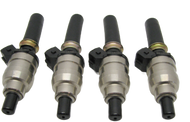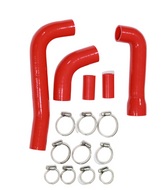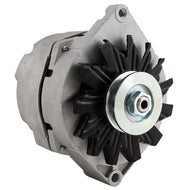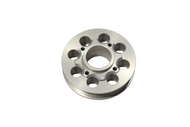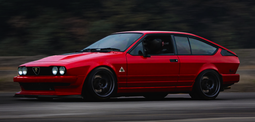Changing Front Torsion Bars and Rear Coil Springs
This procedure is not for amateurs. You can be severely injured or killed working on the suspension of this car, or as a result of the suspension work. DON'T do this unless you are an experienced mechanic.
When working on the suspension it’s super important to make sure the car is safely supported on jacks. The suspension bolts are some of the largest and tightest bolts on the car and the force required to loosen them will tend to move the car. If it’s not supported well it could fall and injure or kill you. For an extra measure of safety I like to put the wheels under the car after I remove them. It’s also important to understand that the energy stored in a compressed coil spring or twisted torsion bar is very dangerous. Be very careful with these items.
Rear Springs
If you are changing both torsion bars and rear springs it’s best to start with the rear springs because they are not adjustable for ride height.
Begin with the car on jack-stands, the rear wheels off and the rear suspension hanging down in the fully extended position . Place a floor jack under the central Watts Linkage pivot point and raise the De Dion tube a few inches. Be careful not to raise it enough to lift the car off the jack stands, you want to lift it just enough to take stress off the bolts we will have to loosen.
Now disconnect the Watts linkage at the outer ends near the wheels. You will need two 17mm wrenches to do this. Do not disconnect the Watts Linkage at the center of the De Dion tube. Once the nuts are off and the bolts are out tap the linkage free from its mounting point on the chassis.
Next you must disconnect the Anti Sway bar from the De Dion tube. It connects in two places, one near each coil spring seat. Your car will have either one 17mm nut at each end or a 17/19mm double nut combination. If your car has the double nut arrangement use a 19mm wrench to hold the nut still while you remove the 17mm nut. Then remove the 19mm nut. Once you have removed the nuts from both sides of the Anti Sway bar you can raise the whole bar to free it from the De Dion tube. As you do this be sure to collect all of the bushings and metal bushing seats. They will tend to fall out and roll all over the place. Note that there are two totally different types of sway bar links. The earlier type is bullet proof, but the later type can be damaged if care is not takes when bolting or unbolting the link. When working with the later type use a wrench to brace the link while you turn the nut to prevent it from twisting and becoming damaged.
Now disconnect the rear shocks from the De Dion tube. They will be held on with either 17mm nuts or the 17/19mm double nut combination. Remove the nuts and compress the shock by hand to get it up and out of the way. Collect the rubber shock bushings and the metal bushing seats. If you car has gas shocks it will be necessary to remove the shocks from the car because they will extend and get in the way. If that’s the case remove the rear seat and unbolt the tops of the shocks. The shock’s top mounts are behind the upper rear corners of the rear seat’s backrest. The nuts there are a little difficult to remove and you have to be really careful not to drop them. If you do they may fall between the fuel tank and the rear seat. Fishing those out of there takes about an hour so don’t drop them.
Let the floor jack down to fully extend the suspension. It will go down a long way.
Now it’s time to remove the coil springs. It’s best to remove the passenger side spring first. It’s also best to install that side first. You could do the driver’s side first but you will probably need a coil spring compressor to do it. Just do what I say and start on the passenger side
In the picture below you can see the shock, Watts Linkage and Anti Sway Bar have all been disconnected and the spring has been removed.

To get the spring out simply push down on the wheel hub area and wrestle the spring out. Then go and do it on the driver’s side. Once the springs are out look up at the top of the spring seat area to make sure that the spring’s upper seats are out. They sometimes stay up there and the spring comes out by itself.
Installing springs is fairly easy. It’s a lot easier with shorter hi performance springs. If you are installing stock springs you may need a coil spring compressor, although it can be done without it. It’s very important to make sure the springs rest correctly in the spring seats. This isn’t too difficult at the bottom where they connect with the De Dion tube however it’s quite easy to install them incorrectly at the top. To make sure they seat correctly at the top I suggest using Duct Tape to secure the spring seats to the springs before you put the springs in the car. That will make sure they stay in the proper orientation when you wrestle them into position. Notice that the spring’s orientation to the spring seat is critical at the top and bottom, however the seat’s orientation to the car doesn’t matter at the top. However at the bottom the spring seat can only rest correctly on the De Dion tube in one position.
Once the springs are in, raise the De Dion tube with the floor jack a few inches. Again, not enough to raise the car, just the De Dion tube. Now reattach the Shocks, Anti Sway bar end links and the Watts Linkage. DO NOT tighten the Watts linkage or anti sway bar bolts. They need to be loose until the suspension is in it's at rest position on the ground. (if you are using polyurethane bushings it’s OK to tighten them now). Put the wheels on and the car back on the ground. Bounce it a few times and then tighten the Watts Linkage bolts with the car on the ground.
Torsion Bar Removal, Installation and Ride Height Adjustment.
Torsion bar work is difficult and time consuming. Don’t start this project at noon if you need the car to drive to a wedding at 4PM. Get the car up safely on jack-stands and remove the front wheels.
Remove the front Anti Sway bar. It’s held on with 13mm nuts and bolts, six of them. You will need to disconnect it at the Lower suspension arms and the mounts at the chassis. Now pick a side to start with, it doesn’t matter if you go to the driver’s or passenger’s side.
Now remove the shock. You could get away with just unbolting it from the lower suspension arm but trust me, it’s best to remove it. It’s easy, two 13mm bolts hold it to the lower suspension arm and a larger size, usually a 17mm secures it to the top. Earlier GTV6s have the old 17mm/19mm combo at the top of the front shock.
Next you will have to remove the Castor Rod from the Upper Link. The upper link is the upper suspension arm and the Castor rod is the rod that connects it to the chassis in the forward area of the wheel well. The Castor Rod is attached by a 17mm bolt and nut. You may need to remove a cotter pin before removing the nut, most GTV6s have a cotter pin, most Milanos don’t. Once the nut is off remove the bolt and the Castor Rod will separate from the Upper Link.
Now we start with the more difficult work. The Upper Link must be separated from the Suspension upright, which is the part that has the spindle the wheel rides on. Remove the 19mm nut that secures the upper ball joint. Then with a quality ball joint separating tool (that means NOT a pickle fork), separate the ball joint. Be aware that when the upper link pops free it will do so with a lot of force driven by the torsion bar. Nothing will be supporting the suspension upright and brake assembly unless you put something under it. If you fail to put something under the brake assembly the brake line could be damage by stretching.
This picture shows the front suspension ready for torsion bar removal. The sway bar, castor rod, shock, have been disconnected and the upper ball joint is separated.

Alert! Before you go any farther it's very important that you take a measurement for ride height adjustment. You need to measure from the A arm to any fixed point up above on the car (like the top of the wheel well). You will use this measurement to raise or lower the car later. You will need to make the exact same measurement again later so be sure to mark points on the A arm and on the car where you measured so you can measure from the exact same points again later. The measurement needs to be taken from the outboard section of the A arm or you will really make things difficult for yourself. If it's taken far enough out then a 1 inch change in A arm position (set later) will equal a 1 inch change in ride height. If not you will change the A arm's position an inch and find you changed ride height a lot more. Write down the measurement!
Now you are ready to remove the torsion bar. At the back of the torsion bar is a little cover plate. It pops out on some cars, earlier models have a bolt on cover plate. Remove the plate. When you look at the back of the bar you can see it has a threaded hole. That hole enables you to use the official Torsion Bar Removal Tool which you can get at your local Alfa Romeo Dealer. Oh wait! That’s not an option, well no problem, there is another way. Get yourself a socket that has an inner diameter larger then 27mm, a bolt that will screw into the torsion bars and a lot of washers that the bolt can pass through. For the factory torsion bars and most other types, you need a bolt with a 10mm diameter and a 1.25mm thread pitch. This size bolt usually has a 17mm head. These items will enable you to make a nice torsion bar puller.
Shove a small screwdriver into the threaded hole at the back of the torsion bar so you understand how shallow the hole is. Now put the bolt through a washer and socket and thread it into the torsion bar. As you tighten the bolt the torsion bar will be drawn back. After it moves back a little remove the socket and add some washers to prevent the bolt from bottoming out. You can keep doing this until the torsion bar is free or once the bar has moved you can pry it the rest of the way out. Caution!!! It's quite easy to damage the threads in the hole by bottoming out the bolt. The threads are not very deep. You will have to move the torsion bar back about 1/2 inch at a time, then add washers and draw it back another 1/2 inch. In almost all cases after you get it back the first 1/2 inch you can pry it the rest of the way.
Here you can see my homemade torsion bar removal tool. Since I have the bar out a little I have inserted a pickle fork to pry it the rest of the way. That’s a lot faster then turning the bolt and changing the amount of washers.

If you are only adjusting ride height and not removing and replacing the torsion bars skip the next steps and go down to the ride height adjusting section.
Once the torsion bar is free from the suspension arm you can remove the suspension arm from the car and slide the torsion bar out the front. Put the new bar in and if it’s a 25.4mm bar or smaller slide it back through the mounts and reattach the suspension arm. Set the ride height as discussed later and put everything back together.
With larger bars, like 27.3mm ones they will not fit through the rear mount. That means you have to install them in the rear mount and then slide the lower suspension arm over the splines and bolt the suspension are in place. This means that every time you need to make a ride height adjustment you will need to remove the lower arm. This is a huge pain in the butt.
When you put the suspension arm onto the torsion bar you will notice that the arm prevents the bolts from going back into the chassis. You will have to pry the arm down out of the way to get the bolts in. It takes a very strong 6 foot long pry bar and a 200+ pound person to move the arm low enough for a second person to put the bolts in. It also helps to place a bottle jack under the “A” arm’s pivot point to keep the bolt holes lined up, otherwise the “A” arm will move down a little when you pry the bar making it very very hard to put in the bolt.
There are a couple other methods that I don’t think work as well. One is putting the bolts in from the other side by raising the engine off its mounts. On some early cars you can remove the rear torsion bar mounts which eliminates the need to use the other methods. I have seen some people grind metal off the A arm to create clearance for the bolts. I don't think this last option is a good idea. If you are working by yourself these optional methods are the only good ways to do it.
Here I am prying the Lower Suspension arm down so I can remove the bolts holding it too the chassis. This is only necessary on later cars with torsion bars larger then 25.4mm. On all others the torsion bar can slide out the back of the arm allowing it to move down out of the way.

Adjusting Ride Height:
Ok, I hope you wrote down that measurement I told you to take before you removed the torsion bar. There are a few ways to set ride height. The official method involves counting splines on the torsion bar and moving a certain number of splines on the back and a certain number on the front. While I am sure this method works, for some reason whenever I try it while lying on my back under the car I seem to screw it up. The problem seems to be that I can't count really small hard to see things after working on the car for a couple hours and lying on my back trying to keep track of which way is clockwise etc. So as you may have guessed I have another way of doing this which works very well and is a lot easier then it sounds.
If using 25.4mm bars or smaller, slide the bar back out of the way. Put never seize on the splines, or if you don't have that use some sort of lubrication. Now set the A arm in the desired position. If you want to lower the car one inch set it one inch higher then it was when you measured it before removing the torsion bar. If you want it a 1/2 inch higher then set it 1/2 inch lower. The only trick here is to make sure you measure it the same way you did before you removed the torsion bar.
Now go to the back of the torsion bar and push it forward into the A arm's splines. It probably won't go in ( you have about a 1 in 25 chance that it will ). The problem here ( and the reason that ride height is so finely adjustable ) is that the front of the torsion bar has a different number of splines at each end. With the A arm in any given position the front splines will only line up in one of the rear splines 25 available positions. So rotate the torsion bar either direction, one and only one spline. Try to put it in now. You may need to tap on the back of the torsion bar with a hammer. Keep trying the different positions until the torsion bar slides forward into the forward A arm. You can actually do this really fast with two people. It helps if one person is at the front looking at the front splines to see when they line up.
Now put everything back together except the anti sway bar, and lower the car. Bounce it a few times to set the suspension and measure the ride height. It should have changed about the desired amount. Keep in mind the total effect won't be seen until both sides are adjusted. In other words if you lowered the left side 2 inches but have not done the right side yet you may not see the full two inch decrease in ride height until you adjust the right side.
Almost Done!
Of course you will have to go through all of this on both sides of the car. It goes A LOT faster on the second side. Be sure to put everything back together correctly and don't forget to connect the anti sway bar when you are done!



